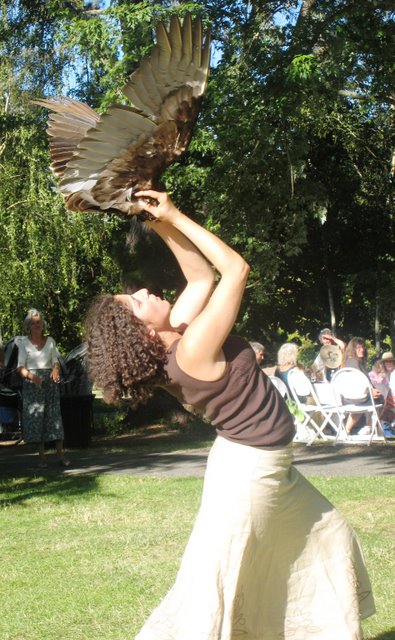The International Dreams Conference has passed us by. It was a hot week in Sonoma, but the rooms were cool. Tempers were cool too, at least that’s what I gathered. Gentle dreamers from all walks of science: psychologists and psychiatrists, anthropologists, poets, shamans, and students all.
I somewhat remember wine, at some point, and the wine tasting that was more like a cascading. At that point, dream performer Lana Nasser emerged from the trees as a bird and adventured around on the outskirts of civilized white tablecloth conversations in a decidedly bird-like manner. (Photo credit: Bhaskar Banerji)
There was science, too. Mark Schroll led a dynamic panel on the subject of Bohmian science and its implications for sacred sites, ecopsychology and spiritual emergence. Stanley Krippner presented his experimental dreaming research into megalithic sites in England and Wales. This pilot study is frought with issues, but paves the way for dream fieldwork in a new way, in which the content of dreams is considered in relationship with landscape, not merely a habit of cultural or personal predispositions.
The study was ultimately not convincing that the ancient sites affected the bizarreness of the researchers” dreams, yet Krippner acknowledges that his hope is that “someone takes it on from here.” I”m glad to see this presentation in debate; it goes against the scientific materialist paradigm, so the variables have to be isolated well. This is pioneering work nonetheless and close to my own research interests in imaginal archaeology.
Also, Curt Hoffman, dream researcher and archaeologist, presented his self-study on how visiting novel places (new cultures and landscapes) can permeate dream content. He found that the highest instance of dreams with elements of those places occurred within the month following his trips.
In particular, Hoffman suggested that the average delay of sense of place – or the spiritus loci – is about five days. So don’t feel too bad if you don’t have a powerful dream on a weekend camping trip that only lasts two nights. Wednesday night, get some sleep and it may well turn up, as long as you don’t fall asleep watching reruns of “Matlock” or engaging in other dream-snuffing behavior.
Personally, I”m a sucker for watching “Quantum Leap” in inappropriate intervals.

Excellent summary of this symposium Ryan! For those that missed it Stanley Krippner will post his paper on “A Preliminary Study of Sacred Sites in England and Wales and Home Dream Reports” on Tuesday Oct. 4, 2008, as his contribution to the 6th Annual PsiberDreaming Conference http://asdreams.org/psi2007/presenters.htm
Curtiss Hoffman will also post his paper “Dream Delay, Dream Decay” to the PsiberDreaming conference on Thursday October 4, 2008. Mark A. Schroll will energize our cognitive electrons with a quantum leap opportunity, “Further Clarification on Ullman’s New Abode: Recognizing the Limitations of the Holographic Paradigm.” Schroll’s essay is divided into five parts: 1) Ken Wilber’s criticism of the holographic paradigm. 2) Bohm’s response to Wilber’s criticism. 3) Gordon G. Globus’ defense of Bohm’s holistic physics. 4) The holomovement: Bohm’s initial narrative construction of wholeness. And 5) The holoflux: Bohm’s continuing attempt to construct a language and conceptual understanding of wholeness. Montague Ullman too will be available as a discussant on Monday October 1 for Judy Gardiner’s essay “Circling the Cosmos on a Dream.” and Monte graciously gave his time to comment on a previous draft of Schroll’s essay. Come and join us; we’re actually not as scary as our titles.